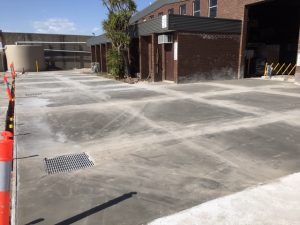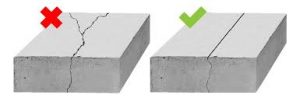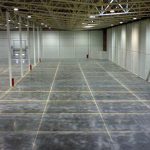
Concrete is an essential part of the construction industry. It’s used in a variety of ways, from building commercial and residential buildings to footpaths and driveways. While concrete can be strong, durable, and attractive when it’s finished properly, cracks are common problems that appear over time. This issue becomes more noticeable if the necessary measures are implemented to prevent such cracking before it happens.
Reasons For Cracks In Concrete

What Are Expansion Joints?

When Should Expansion Cuts Be Installed
Once the concrete for a slab is poured a control cut needs to be made with a concrete saw within 6-18 hours afterwards to avoid the risk of randomised cracking. The cut is not actually made the entire way through the slab but only at one-quarter the depth of the concrete. This creates enough of a weak point and encourages the crack to appear where you want it to.
Benefits Of Cutting Expansion Joints In Concrete
Concrete is a strong and durable building material however, as we have discussed earlier, it can be prone to cracking if not properly cared for. One way you can care for your concrete slab is by cutting expansion joints in the surface with specialised concrete saws.
Expansion joints help to prevent cracks from forming and splintering as the slab expands or contracts with changes in temperature, moisture levels, freeze-thaw cycles etc. Cuts like these allow for perpetual movement of the concrete without compromising the integrity of your surface. Most importantly, this is why they are required.s
How To Cut Expansion Joints In Concrete

Other factors to consider are the type of saw used and the blade choice. For this reason uncured concrete is not damaged or disturbed by the saw machine as it travels across the surface of the concrete. It is also important to space out the control cuts by the right distance. Too far apart and you will get random cracking appear in between control cuts. Too close and you reduce the aesthetic look by having more cuts than you actually need.
To Summarise
The best way to avoid cracks in concrete is by cutting expansion joints. If you cut the right size and length, your concrete will not crack when it expands or contracts with changes in temperature. Following these simple tips you can ensure that your concrete pavement won’t break apart during extreme heat waves, cold spells and drastic changes in weather patterns. Always contact a professional when making saw cuts in concrete as this can be a very technical process.
If you are looking for a specialist concrete cutting company who uses only the best practices to get the job done right, then please call us at Big Cut Sawing on 0409 066 660 or contact us through our website www.bigcutsawing.com.au
